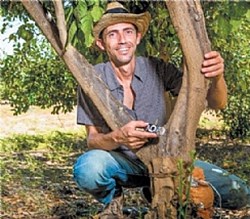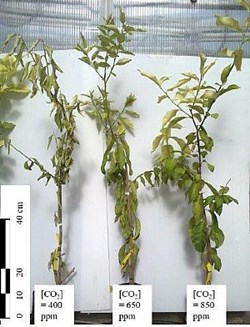
Among the many ongoing changes inflicted on our climate and atmosphere, the increase in CO2 level has been the most consistent, with about 1.5-2 ppm annual increase. CO2 is the substrate for plant photosynthesis, and hence the expectation that the more CO2 we emit to the air, the more CO2 is available for plant growth. Indeed, CO2 fertilization has been used successfully to increase yields in greenhouses. Yet, in the majority of scenarios outside the greenhouse, plant growth is limited by other factors, such as light, water, and nutrients. Therefore, so far, global crop yields have not benefitted from surplus CO2.
The little, if any, CO2-induced growth increment does not mean that plants are insensitive to CO2.
Plant growth is a complex phenomenon, which is highly regulated at multiple genetic and molecular levels.
Thinking about the physiological consequences of elevated CO2 on trees, the research team of Dr. Tamir Klein, at the Weizmann Institute of Science, set out to test a new hypothesis.
In many plant species, stomata become less active as CO2 increases. This is because photosynthesis is usually adjusted by plant growth demands. Nevertheless, at high CO2, even when stomata are less conductive, diffusion dictates that more CO2 is absorbed than under low atmospheric concentrations. Again, this carbon is not channeled into enhanced growth, but rather into storage in shoots and roots.
Together with his partners at the Gilat research station (ARO Volcani), Dr. Eran Raveh, and Dr. Uri Yermiyahu, Tamir’s team established a greenhouse experiment on sixty 1-year-old lemon saplings, under three CO2 levels: 400, 650, and 850 ppm. While the first level represents current atmospheric conditions, the latter are levels predicted in the years to come. The scientists hypothesized that the lower stomatal conductance should mean a decrease in transpiration, and in turn, reduced tree water-use; and that the higher carbon storage means increased safety under stress conditions. Interestingly, both mechanisms can improve the tree’s response to drought.

Following the four months of the drought experiment, young lemon trees grown under the elevated CO2 levels showed the expected responses: they were less stressed by drought, showed less negative water potentials, and had higher carbon reserves in the form of starch.
Moreover, since trees under elevated CO2 used ~30% lower amounts of water than under current CO2 level, they had higher soil water content when drought was imposed on them. These responses showed that the elevated CO2 compensated for drought effects on these trees, yielding healthy trees in spite of the imposed stress.
What are the implications of these findings? Along with the CO2 increase in the atmosphere, temperatures increase globally, and precipitation amounts decrease locally, in Israel and across the Mediterranean.
It is possible that future crops could use the one man-made ‘evil’ (elevated CO2) to cope better with the other man-made ‘evil’ (drying). The results of the lemon experiment offer a less pessimistic scenario for future agriculture under drought than is currently perceived.
On a more practical note, using elevated CO2 in greenhouses today can already decrease irrigation amounts. In addition, higher drought tolerance of crops can enhance their expansion to drier, more marginal, areas, in Israel and in other countries.
